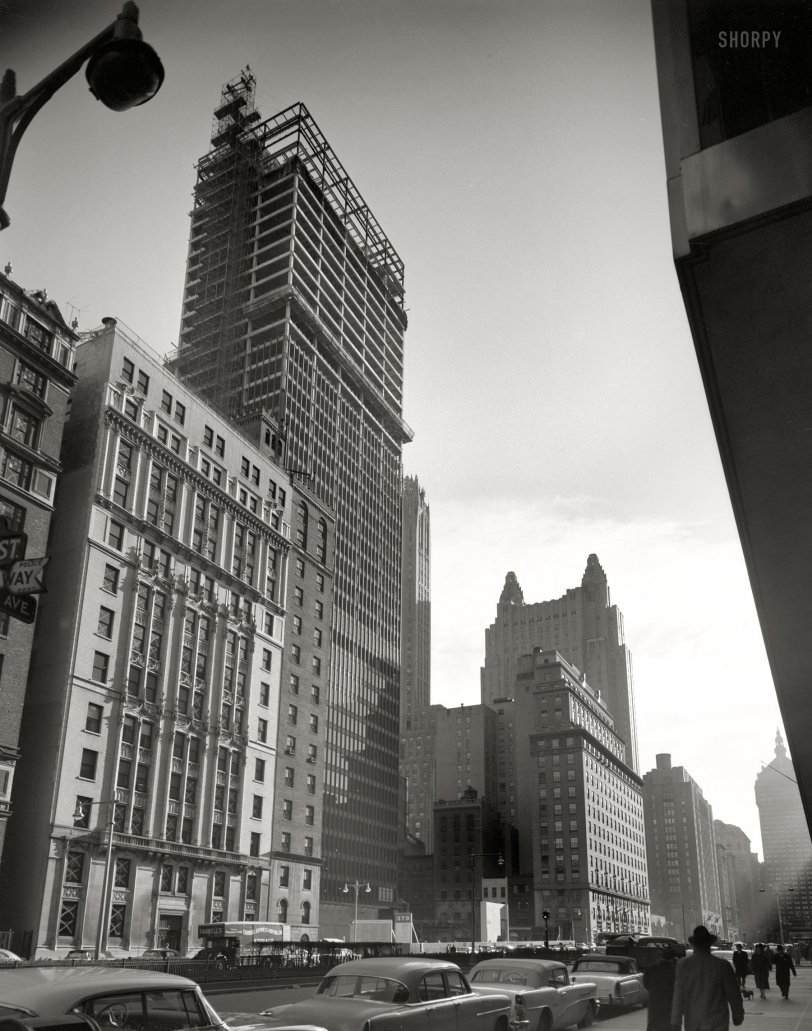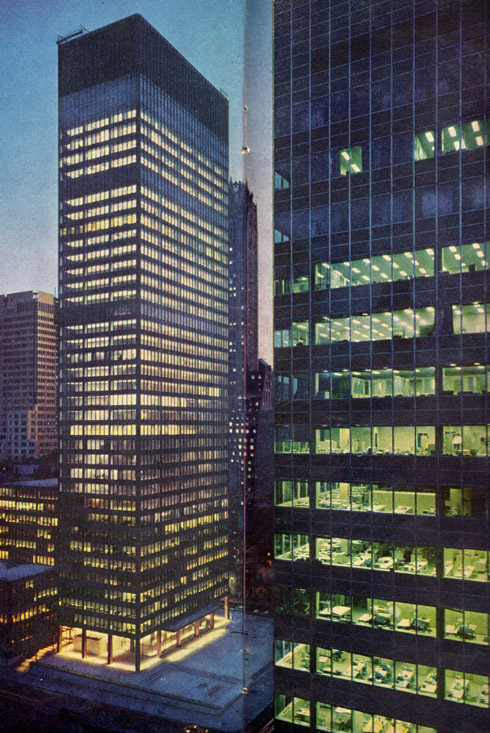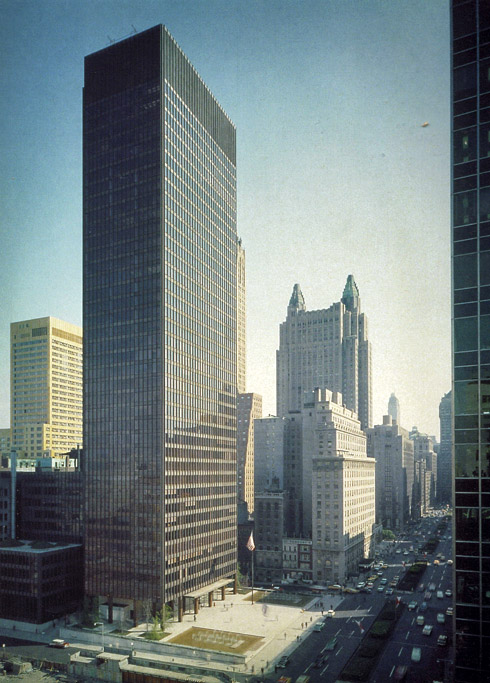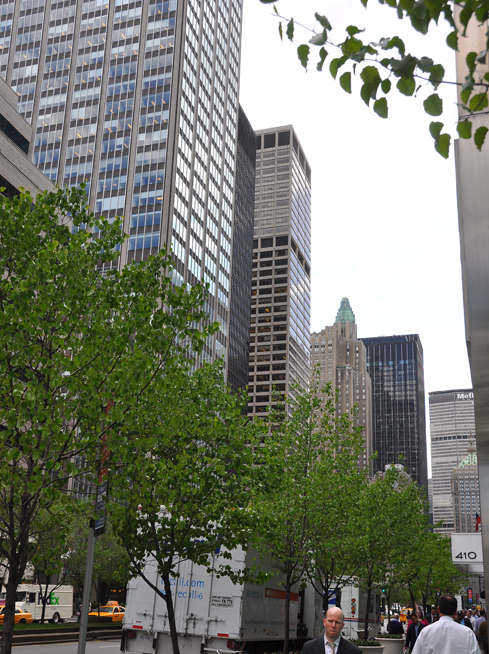


Framed or unframed, desk size to sofa size, printed by us in Arizona and Alabama since 2007. Explore now.
Shorpy is funded by you. Patreon contributors get an ad-free experience.
Learn more.

- Lost in Toyland
- And without gloves
- If I were a blindfolded time traveler
- Smoke Consumer Also Cooks
- Oh that stove!
- Possibly still there?
- What?!?
- $100 Reward
- Freeze Frame
- Texas Flyer wanted
- Just a Year Too Soon
- WWII -- Replacing men with women at the railroad crossing.
- Yes, Icing
- You kids drive me nuts!
- NOT An Easy Job
- I wonder
- Just add window boxes
- Icing Platform?
- Indiana Harbor Belt abides
- Freezing haze
- Corrections (for those who care)
- C&NW at Nelson
- Fallen Flags
- A dangerous job made worse
- Water Stop
- Passenger trains have right of way over freights?
- Coal
- Never ceases to amaze me.
- Still chuggin' (in model form)
- Great shot
Print Emporium
Seagram: 1957

New York. January 23, 1957. "Seagram Building, Park Avenue. Oblique view from northwest." Large-format negative by Gottscho-Schleisner. View full size.
"Curtain Wall" Buildings
The term "curtain wall building" is misleading, because the curtain wall was developed hand in hand with the structural innovation called the "skeleton frame" - which was developed in Chicago in the 1880s. Early skyscrapers had curtain walls made of brick, stone, and terra cotta; these curtain walls were not self-supporting but rather "hung" from the skeleton frame (usually iron, steel, or later reinforced concrete). The first skeleton frame building in New York was the Tower Building at 50 Broadway (Bradford Gilbert, architect, built 1888-1889, demolished 1914); this was exceptional because skeleton frame construction was not permitted by the New York City Building Code until 1892. The use of metal and glass for curtain walls was introduced by Pietro Belluschi in the Equitable Building in Portland, Oregon (1944-1947). The idea for the metal and glass curtain wall is generally attributed to Ludwig Mies van der Rohe. He designed theoretical projects for such buildings in Berlin in 1921 and 1922, but his first built examples were two apartment buildings in Chicago at 860 & 880 North Lake Shore Drive (built 1948-1951). In the Seagram Building, Mies adapted his design for 860 & 880, with one major change: the mullions on the facade are not steel, but bronze.
World's most overrated building
Yes, it has better proportions and better materials than most modernist office towers, but that's like saying a particularly nice coat of fur makes one rat more attractive than other rats. At the end of the day, it's still a rat.
It's cold and dehumanizing, removed from street life by an unused plaza and windows that cannot open. The ceilings are low. The fluorescent lights are oppressive. The orange tinted windows make everyone inside look jaundiced.
The perpetual praise it gets from architects and critics — it routinely ranks among the ten most celebrated buildings of the past century — shows how barren those professions still are and why we are utterly incapable of building new environments that regular people love as much as those that predate WWI.
[I've visited the Seagram Building and the Four Seasons restaurant a number of times. They still count among the higher attainments of American civilization. - Dave]


Xs on Windows
An "X" pattern of tape (masking or duct) is often placed on window panes to reduce the possibility of the glass shattering when being removed. In this case, possibly it was done because of vibration caused by the construction of the Seagram Building? And the one on the far left, fancifully turning the small windows into tic-tac-toe games as a sly reference to that procedure?
Thoroughly Modern
The Seagram Building is a remarkable piece of architecture in its own right, but it also served as the turning point for several architects (including Philip Johnson) and was a prototype for many of Mies van der Rohe's building in the 1960s and '70s. Chicago, Montreal and Toronto all have Seagram Building "clones."
+53
Below is the same view, south from 53rd Street, taken in April of 2010.

Manhattan Tic-Tac-Toe
What's with the markings on the windows of the three buildings at left? At first I thought all the X's were an indication the buildings were marked for demolition but some of the smaller windows have a pattern of X's and O's. Anyone know the significance?
Bright Lights, Big City
As a contractor in NY I have spent many days in this building and even though most people would pass it by and consider it in the same era as multiple other NYC buildings the mechanical infrastructure was decidedly from a past time. On another note the mostly underrated original GE building with its Deco crown is visible to the Seagram's right also a few blocks down is the Waldorf. Of interest to me at least the very Deco park ave light poles are still up with the original mercury vapor luminaires, also the last of the "greenies" two-light cast iron traffic poles are still in the median. I work for one of the companies that maintain and install NYC traffic and street lights.
Watershed Building
1st "curtain wall" constructed building in US? World?
[The first curtain-wall building in New York was 1952's Lever House. Earlier examples elsewhere in the U.S. go back to the turn of the century. - Dave]
Four Seasons restaurant is in the 51st Street side of the building. If you keep walking east on 51st and get to Lexington Avenue, that is where the famous photo of Marilyn Monroe with her dress blown up was taken. Manhattan -- something happened almost everywhere.
























On Shorpy:
Today’s Top 5